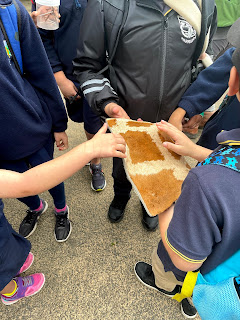In Term 1, our art was inspired by our Inquiry learning about Taha Tinana (Our Physical Wellbeing). Throughout the term we were learning about different ways our bodies can move and so we developed some Sporty Portraits to show the different sports we enjoy and the ways our bodies can move.
Unlike our self-portraits (which we did individually), we needed each other to get the best images for our artworks. We started out by acting out a sport or activity we like. We talked about how to exaggerate (make bigger or extend) our movements so it was clear what type of sport we were playing. We also thought about the lines our arms and legs were making away from our bodies, so our audience could see our direction of travel. We wanted to make silhouette pictures, so our actions needed to be clear to communicate our movement. Here's an example from Google images that shows someone jumping:
 |
| Image credit: https://commons.wikimedia.org/wiki/File:IMG_6616-william-roberts_Noosa-Australia-2018_girl-jumping-silhouette_beach_sunset_3024x4032.jpg |
Then we worked with a buddy to take a photo of each other with our Chromebook camera. It was pretty tricky to get a picture with our whole body in it and not distorted by the angle of the Chromebook screen. We also had a hard time moving our whole body, rather than just an arm to throw or leg to kick. We looked like stick people not sportspeople! We needed to rethink our tools so our project could continue more successfully.
Our next attempt at getting pictures was heaps of fun. Mr Hing-Windsor gathered a bunch of sports equipment and we worked with a buddy or small group to play with the equipment outside for a short time. Then we would swap equipment with another group and try that out. The teachers whizzed around to take photos on their phones of each person in action. There were plenty of duds in that set of photos too, but everyone was captured in a great pose at some point. Everyone got plenty of exercise that afternoon.
For our following art session, we were given a print out of our photo. We each carefully cut out our body. Sometimes it was hard to see where to cut on a black and white copy, so a few of us got another copy so we weren't missing an elbow or foot. It was helpful to roughly cut around and then go more slowly to use our scissors more accurately. We remembered the advice from Miss McGrath to cut using the part of the scissors where the blades join, rather than the blade tips. It was a lot easier to move the paper and hold the scissors steady than tie ourself in knots as we moved the scissors around our picture!


 We glued the cut-out of our body to thick black paper and then cut it out again. Not everyone finished this step and our buddy could help if we were having trouble, so it was cool for the teachers to see lots of cooperation at this stage too. Mrs McLellan finished cutting some bodies out for people. She discovered that fingers and hair go in lots of directions when we play sport!
We glued the cut-out of our body to thick black paper and then cut it out again. Not everyone finished this step and our buddy could help if we were having trouble, so it was cool for the teachers to see lots of cooperation at this stage too. Mrs McLellan finished cutting some bodies out for people. She discovered that fingers and hair go in lots of directions when we play sport! |
Image Source: https://menloparkart.wordpress.com/art-smart-links/ |
As we neared the end of the term we were pressed for time to complete our backgrounds. The teachers decided to use digital tools to give us time to experiment without having to wait for paint to dry or space for another turn. This helped speed up the process and most of us could choose our favourite background to use. We learned about the colour wheel and how colours on opposite sides of the wheel are called complementary colours. They can stand out from each other really clearly so they are useful when we are using colours in other work too, like making an infographic about our learning in reading or publishing our writing. Here is a link to the activity we did, allowing us to choose different digital tools to make a background.
When our backgrounds were printed out in colour we could glue our silhouette onto the space. We needed to think about how our body was interacting with the sports equipment. Our next task was to draw our sports equipment on some scraps of the thick black paper. To give our final artwork more impact, we exaggerated the size and shape of the equipment so it looked like it was coming out towards the viewer. This is a way of playing with perspective.
Finally our work was mounted on a plain background by the teachers. They had intended to display all the silhouettes from our group together but they were so amazing and unique that almost all could be mounted individually. Just the group using the long skipping rope couldn't be separated in a way that made sense!
Here's a selection of our finished Sporty Portraits.



 Which sport would you try to show, if you could make your own Sporty Portrait?
Which sport would you try to show, if you could make your own Sporty Portrait?






































